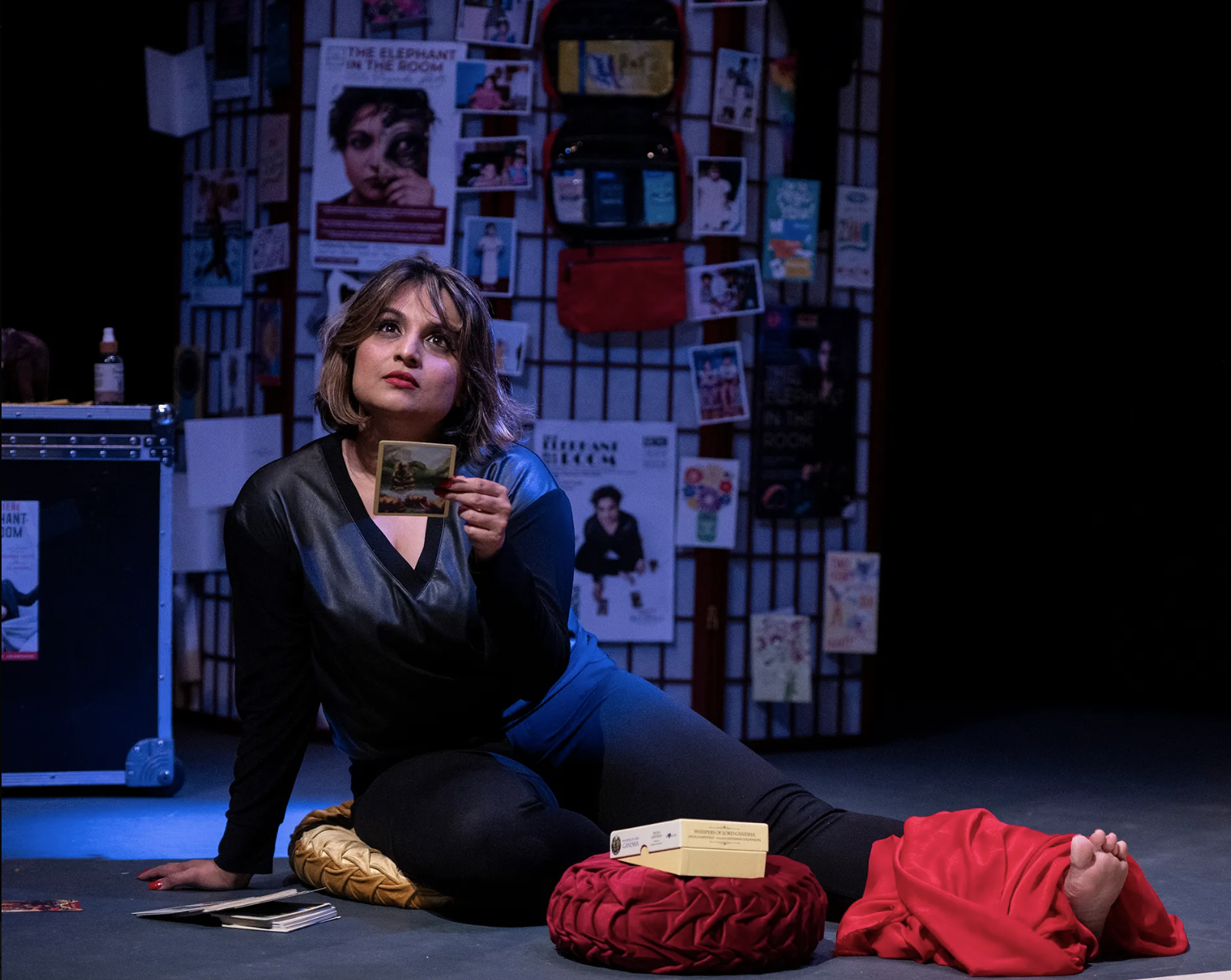Review: Priyanka Shetty Consults the Cards in Keegan’s ‘The Elephant in the Room’
Portraying oneself is hard, but in this very meta solo show, it’s the personal components of Shetty’s story that prove most engaging.
By D.R. Lewis
June 17, 2024
This review originally appeared in Washington City Paper.
Temperance. The Magician. The Moon. The Devil. One by one on her dressing room floor, playwright and performer Priyanka Shetty reveals the tarot cards in her shuffled stack, allowing their meanings to guide her through a string of personal stories and epiphanies in The Elephant in the Room. Over the course of Shetty’s 90-minute solo journey, running at Keegan Theatre through June 23, she delves into love, loss, and determination to gain greater understanding of what it means to belong.
The Elephant in the Room begins with Shetty, portraying a version of herself, pacing in her dressing room before performing this same play. Nervous that her parents are waiting in the audience after having flown in from India, she discovers a mysterious package containing tarot cards illustrated with the Hindu deity Ganesha (who has the head of an elephant, Shetty’s favorite animal). As she flips through the deck, the various cards inspire her to take stock of the revelations and relationships that have driven her to this nerve-wracking moment, and the hurdles that remain in her way. The emotional turmoil the cards conjure leave us wondering whether Shetty (the character) will end up performing the play (within the production we’re watching) at all.
In constructing The Elephant in the Room, Shetty (intentionally or not) has essentially landed on two distinct sections: cultural criticism and personal narrative. While the two parts are linked by some loose connective dramatic tissue, her evaluation of what it means to have an identity shaped by Indian culture, legacies of British colonialism, and American culture make up the bulk of the first half. These sequences unfold almost as a stand-up comedy routine, with extended commentary on concepts like “vulnerability,” heavy metal music, and yoga as a “booming industry.”
After sizing up the cultural forces around which she navigates, Shetty transitions into the complex relationships that shaped her decision to quit a software engineering job in India and pursue a master’s in acting at the University of Virginia. These personal components of Shetty’s story prove more engaging and allow her to exercise greater command of the audience.
Portraying oneself is an extremely difficult endeavor. Shetty achieves the greatest synergy between her writing and her performance when reenacting exchanges between those who’ve shaped her life: her parents, brother, aunties, and romantic interests among them. In these moments, Shetty is able to settle into an organic rhythm, at times relaxing so deeply into the sequence that she appears to be reliving the conversations spontaneously. Rather than attempting to connect with the audience across the lip of the stage, her gaze often strays upward or to the sides of the theater, somehow fostering a deeper, quieter intimacy than when she is explicitly breaking the fourth wall.
Emerging out of these moving moments, which make up much of the stronger second half, however, Shetty struggles to bring the show to a tidy, satisfying end. In the play’s final moments, Shetty (the character) resolves to put self-doubt aside and perform for her parents as planned. She declares strongly that she has “been afraid” of letting people down and has essentially allowed others to determine her path. While this affirmation is noble and encouraging, it’s also puzzling.
Her story is, by any account, one of strength, perseverance, and self-determination. Once a precocious child, she became a successful software developer, authored a well-respected blog, started a theater troupe, left a stable career to pursue her artistic calling, earned a full scholarship, immigrated to the U.S., and, when she struggled to land satisfying roles, authored and performed her own show. On their own, any of these accomplishments exhibit great drive. When taken together, they’re extraordinary, especially considering the family and cultural dynamics Shetty identifies as barriers. In implying that she had been a pushover to this point, Shetty inadvertently undermines all of the courage she has shown over the previous 85 minutes. And by dismissing the parts of her story with which the audience has come to identify and admire most, Shetty suddenly muddles her message at its greatest potential for impact.
Director Suli Holum has Shetty often moving between three or four distinct stage zones—each signal a narrative shift (the relatively sparse, but carefully color-coordinated scenic design is by Dirk Durossette). A few cushions in the downstage right corner are home to the splayed tarot cards and often signal a transition into a new story or emotion. A chair at the stage’s center is often home base for telling lengthier stories. An upstage dressing table generally brings emotional revelations. And two towers on both sides of the stage illuminate the various tarot cards that serve to incite new stories and breakthroughs (lighting designer Julie Briski’s practical offerings are subtle but effective).
The Elephant in the Room exemplifies much of the spirit of Keegan’s developmental Boiler Room Series, under which this solo work received a workshop and presentation in 2020. It’s also the first piece in a “triptych” of solo shows from the playwright (the second, #Charlottesville premiered as a solo in early 2021; the final piece, The Wall, is currently in the works, according to her website). As Shetty continues to refine her voice as both a writer and a performer further experimentation with—and exploration of—structure and form will only elevate her promising work. Where will it lead? Consult the cards.
The Elephant in the Room, written by Priyanka Shetty and directed by Suli Holum, runs through June 23 at Keegan Theatre. keegantheatre.com. $45–$55.
Priyanka Shetty, writer and star of The Elephant in the Room. Credit: Teresa Castracane
